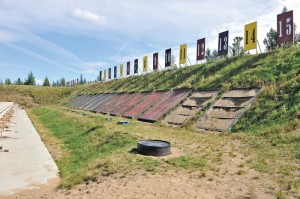Valcartier first to have green firing range
By Lookout on Jan 05, 2015 with Comments 0

The new bullet catchers are easy to modify and adapt to various weather conditions.
2nd Canadian Division Support Base Valcartier has officially become the first Canadian Forces Base to use a green small arms firing range, called the Nicosie firing range.
The new bullet catchers at 2nd Canadian Division Support Base Valcartier caught the attention of a number of project stakeholders during a recognition ceremony on Sept. 9.
The new catchers minimize the environmental impact of military training while ensuring the firing range complies with the Defence Environmental Strategy.
The bullet catchers retain metal residue from small arms projectiles to prevent seepage water from reaching the firing range’s groundwater flow.
In 2007, Defence Research and Development Canada (DRDC) and the Director of Land Environment began considering ways to create an improved and more cost-effective bullet catcher.
After developing and testing various prototypes, the final design was revealed in 2011.
To reduce the speed of projectiles, steel boxes filled with sand were built and installed on the existing range butts, and covered in self-healing membranes.
When bullets puncture the membrane, the holes close over on their own.
Receptacles developed by Institut national de recherche scientifique (INRS) collect the effluent made up of seepage water, directing its flow toward a treatment system.
Valcartier military members have been training with these catchers for two years to measure the effectiveness of the self healing membrane and the cells’ impermeability.
The catchers bore these trials well, and an independent study found they were 54 per cent more economical than the conventional sand butts after 20 years of use.
This level of performance offers a long-term solution for managing metal residues from projectiles and should also reduce the environmental impact to almost zero.
Military members who have tried the catchers had only good things to say about them.
They pointed out that the catchers decrease noise considerably on the firing range and do not change the nature of training in any way.
“We are very happy with the results for the Armed Forces,” says the DRDC Land Science and Technology Director General, Guy Vézina.
“The green firing range project is a great example of multidisciplinary cooperation among a number of organizations, which was undoubtedly the key to this project’s success.
With one of the best catchers in the world, we are helping to ensure the sustainability of firing ranges.”
DRDC scientist Sonia Thiboutot added that many countries concerned about the environmental management of firing ranges are interested in the new bullet catcher design.
A number of partners were involved in this project, including the Director of Land Environment, several 2 CDSG units, including firing ranges and training areas, Resource Conservation and the Engineering Branch, Defence Construction Canada, DRDC, and its environmental expert partner, INRS.
A final report on environmental performance of bullet catchers will be issued in January 2015.
Simon Leblanc
ADSUM NEWSPAPER
Filed Under: Top Stories
About the Author:





